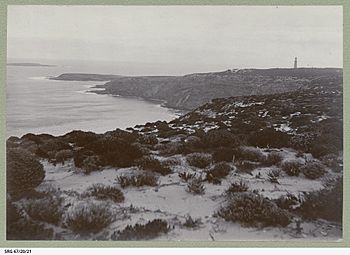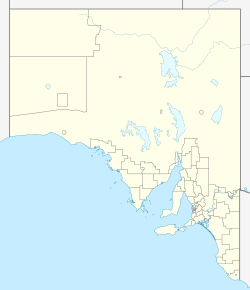Casuarina Islets facts for kids

Cape Du Couedic and the two Casuarina Islands, circa 1912 (State Library of South Australia,SRG-67-20-21)
|
|
| Geography | |
|---|---|
| Location | Great Australian Bight |
| Coordinates | 36°04′01″S 136°42′08″E / 36.06694°S 136.70222°E |
| Area | 4 ha (9.9 acres) |
| Administration | |
|
Australia
|
|
The Casuarina Islets, also known as The Brothers, are two small islands. They are located in the Great Australian Bight, just off the southwest coast of Kangaroo Island in South Australia. These islands are about 96 kilometers (60 miles) southwest of Kingscote. Today, both islets are part of the Flinders Chase National Park.
Contents
Exploring the Casuarina Islets
The Casuarina Islets are about 96 kilometers (60 miles) southwest of Kingscote. There are two main islands: the North Islet and the South Islet. The North Islet is about 370 meters (1,210 feet) south of Cape du Couedic. The South Islet is a bit further, about 2.3 kilometers (1.4 miles) south of the Cape.
How the Islets Were Formed
These islands were created a very long time ago, between 7,500 and 8,900 years ago. This happened when sea levels rose after the last ice age, during a period called the Holocene. Both islets are made of a type of rock called metasandstone. Over thousands of years, ocean waves have smoothed and rounded these rock formations.
The North Islet still has a cap of a different rock called calcarenite on its eastern side. However, the South Islet has lost its calcarenite cap because of strong wave action. The North Islet sits in water about 30 meters (98 feet) deep, while the South Islet is in deeper water, about 40 meters (130 feet) deep.
Plants and Animals of the Islets
The Casuarina Islets are home to many interesting plants and animals. Scientists have studied what lives on each islet.
North Islet's Wildlife
In 1996, a survey found nine different types of plants on the North Islet. Some plants, like round-leaved pigface and sea celery, grow in exposed areas. Other plants, such as nitre-bush and ruby saltbush, prefer more sheltered spots.
Many animals also live here:
- Mammals: The islet has a breeding colony of New Zealand fur seals. This means many fur seals come here to have their babies. Australian sea lions also use the islet as a "haul out" spot, which is a place where they rest on land.
- Birds: You can see breeding colonies of silver gulls, Pacific gulls, and crested terns. Other birds like rock parrots, welcome swallows, and Richard's pipit are also found here.
- Reptiles: Only one type of reptile, the marbled gecko, was found during the survey.
South Islet's Wildlife
The South Islet has fewer plant species, with four types found in 1996. Round-leaved pigface is the most common plant here. Sea celery, ruby saltbush, and Austral seablite also grow on the island.
Animals on the South Islet include:
- Mammals: A group of New Zealand fur seals uses this islet as a resting place, though they don't breed here.
- Birds: Birds like turnstones, sooty oystercatchers, and welcome swallows have been seen.
- Reptiles: The four-toed earless skink is the only reptile recorded on the South Islet.
History of the Islets
The Casuarina Islets were named by a French explorer named Nicolas Baudin. He named them on January 3, 1803. The name "Ilots du Cassuarina" comes from one of his expedition ships, the Casuarina. This ship was commanded by Louis de Freycinet at the time. The islands are also commonly known as The Brothers.
Protecting the Casuarina Islets
The Casuarina Islets are important for wildlife, especially for seals and seabirds. Because of this, they have been protected for a long time.
Early Protection Efforts
In 1909, the South Islet was made a "closed area" to protect birds and animals. This happened because the South Australian Ornithological Association was worried about the New Zealand fur seal colonies. Later, in 1955, the North Islet also became a sanctuary to protect its fur seal population.
National Park Status
Both islets were officially declared fauna reserves in 1967. Then, in 1972, they became part of the Flinders Chase National Park. They are now specifically marked as "prohibited areas." This means people are not allowed to visit them, which helps protect the breeding fur seals and seabirds.
Since 2012, the waters around both islets are also part of a special "restricted access zone." This zone is within the Western Kangaroo Island Marine Park, adding another layer of protection for the marine life around the islands.


